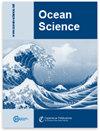Intraseasonal variability of the South Vietnam upwelling, South China Sea: influence of atmospheric forcing and ocean intrinsic variability
IF 3.3
3区 地球科学
Q2 METEOROLOGY & ATMOSPHERIC SCIENCES
引用次数: 0
Abstract
Abstract. The South Vietnam upwelling (SVU) develops off the Vietnamese coast (South China Sea, SCS) during the southwest summer monsoon over four main areas: the northern coastal upwelling (NCU), the southern coastal upwelling (SCU), the offshore upwelling (OFU) and the shelf off the Mekong River mouth (MKU). An ensemble of 10 simulations with perturbed initial conditions were run with the fine-resolution SYMPHONIE model (1 km inshore) to investigate the daily to intraseasonal variability of the SVU and the influence of the ocean intrinsic variability (OIV) during the strong SVU of summer 2018. The intraseasonal variability is similar for the SCU, MKU and OFU, driven to the first order by the wind variability. The MKU and SCU are induced by stable ocean dynamics (the northeastward then eastward boundary current) and have very little chaotic variability. The OIV has a stronger influence on OFU. In July, OFU mainly develops along the northern flank of the eastward jet. The influence of the OIV is strongest and related to the chaotic variability of the meridional position of the jet. In August, this position is stable and OFU develops mainly in the area of positive wind curl and cyclonic eddies north of the jet. The influence of the OIV, weaker than in July, is related to the organization of this mesoscale circulation. The NCU shows a behavior different from that observed in the other areas. In the heart of summer, a large-scale circulation formed by the eastward jet and eddy dipole is well established with an alongshore current preventing the NCU development. In early and late summer, this circulation is weaker, allowing a mesoscale circulation of strongly chaotic nature to develop in the NCU area. During those periods, the OIV influence on the NCU is very strong and related to the organization of this mesoscale circulation: the NCU is favored (annihilated) by offshore-oriented (alongshore) structures.南海南越上升流的季节内变率:大气强迫和海洋固有变率的影响
摘要南越上升流(SVU)在西南夏季风期间在越南沿海(南中国海,SCS)发展,主要包括北部沿海上升流(NCU)、南部沿海上升流(SCU)、近海上升流(OFU)和湄公河河口外大陆架(MKU)四个区域。利用高分辨率SYMPHONIE模式(近海1 km)对初始扰动条件下的10次模拟进行了综合分析,探讨了2018年夏季强SVU期间SVU的日-季内变率和海洋固有变率(OIV)的影响。SCU、MKU和OFU的季内变率相似,由风变率驱动为一级。MKU和SCU是由稳定的海洋动力(先东北后东的边界流)引起的,混沌变率很小。OIV对OFU的影响更大。7月,OFU主要沿东急流北侧发展。OIV的影响是最强的,并且与喷流经向位置的混沌变化有关。8月,该位置较为稳定,ofu主要在急流以北的正风旋度和气旋涡旋区发展。OIV的影响较7月减弱,与中尺度环流的组织有关。NCU表现出不同于在其他区域观察到的行为。在夏季中心,一个由东向急流和涡旋偶极子形成的大尺度环流很好地建立起来,一个沿岸流阻止了NCU的发展。在初夏和夏末,该环流较弱,使NCU地区形成强混沌性质的中尺度环流。在这些时期,OIV对NCU的影响非常强,并且与这种中尺度环流的组织有关:NCU被近海导向(沿岸)结构所青睐(湮灭)。
本文章由计算机程序翻译,如有差异,请以英文原文为准。
求助全文
约1分钟内获得全文
求助全文
来源期刊

Ocean Science
地学-海洋学
CiteScore
5.90
自引率
6.20%
发文量
78
审稿时长
6-12 weeks
期刊介绍:
Ocean Science (OS) is a not-for-profit international open-access scientific journal dedicated to the publication and discussion of research articles, short communications, and review papers on all aspects of ocean science: experimental, theoretical, and laboratory. The primary objective is to publish a very high-quality scientific journal with free Internet-based access for researchers and other interested people throughout the world.
Electronic submission of articles is used to keep publication costs to a minimum. The costs will be covered by a moderate per-page charge paid by the authors. The peer-review process also makes use of the Internet. It includes an 8-week online discussion period with the original submitted manuscript and all comments. If accepted, the final revised paper will be published online.
Ocean Science covers the following fields: ocean physics (i.e. ocean structure, circulation, tides, and internal waves); ocean chemistry; biological oceanography; air–sea interactions; ocean models – physical, chemical, biological, and biochemical; coastal and shelf edge processes; paleooceanography.
 求助内容:
求助内容: 应助结果提醒方式:
应助结果提醒方式:


